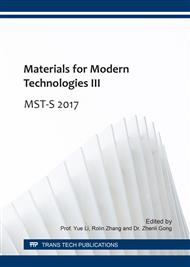[1]
H.Z. Wang, L. Gao, H.G. Chen, L.H. Gui, J.K. Guo, Effect of nano SiC particles on the microstructure of Al2O3 ceramics, J. Inorg. Mater. 13 (4) (1998) 603-606.
Google Scholar
[2]
C.P. Dogan, J.A. Hawk, Influence of whisker toughening and microstructure on the wear behavior of Si3N4-and Al2O3–matrix composites reinforced with SiC, J. Mater. Sci. 35 (2000) 5793-5807.
Google Scholar
[3]
K. Niihara, New design concept of structural ceramics, J. Ceram. Soc. Jpn. 99 (10) (1991) 974-982.
Google Scholar
[4]
J.X. Fang, M.P. Harmer, H.M. Chan, Evaluation of subgrain formation in Al2O3/SiC nanocomposites, J. Mater. Sci. 32 (1997) 3427-3433.
DOI: 10.1023/a:1018672717239
Google Scholar
[5]
C.C. Anya, Microstructural nature of strengthening and toughening in Al2O3/SiC(p) nanocomposites, J. Mater. Sci. 34 (1999) 5557-5567.
Google Scholar
[6]
J.A. DiCarlo, Creep limitations of current polycrystalline ceramic fibers, Compos. Sci. Technol. 51 (2) (1994) 213-222.
DOI: 10.1016/0266-3538(94)90191-0
Google Scholar
[7]
J.J. Sha, T. Nozawa, J.S. Park, Y. Katoh, A. Kohyama, Effect of heat treatment on the tensile strength and creep resistance of advanced SiC fibers, J. Nucl. Mater. 329 (1) (2004) 592-596.
DOI: 10.1016/j.jnucmat.2004.04.123
Google Scholar
[8]
W. Liu, J.C. Li, W.T. Zheng, Q. Jiang, NiAl(110)/Cr(110) interface: A density functional theory study, Phys. Rev. B. 73 (2006) 1-7.
Google Scholar
[9]
R. Hofmann, Solid and Surface, Chemical Industry Press, Beijing, (1996).
Google Scholar
[10]
J.Y. Wang, Y.C. Zhou, Dependence of elastic stiffness on electronic band structure of nanolaminate M2AlC (M=Ti, V, Nb, and Cr) ceramics, Phys. Rev. B. 69 (21) (2004) 1681-1685.
Google Scholar
[11]
S.X. Xiao, C.Y. Wang, T.L. Chen, The Application of Discrete Variational Method in Density Functional Theory to Chemistry and Materials Physics, Science Press, Beijing, (1998).
Google Scholar
[12]
D.Sanchez-Portal, E. Artacho, J.M. Soler, Projection of plane-wave calculations into atomic orbitals, Solid State Commum. 95 (1995) 95-685.
DOI: 10.1016/0038-1098(95)00341-x
Google Scholar
[13]
R.S. Mulliken, Electronic population analysis on LCAOMO molecular wave function, Int. J. Chem. Phys. 23 (1955) 23-1833.
Google Scholar
[14]
G.X. Xu, L.M. Xu, D.M. Wang, Quantum Mechanics-basic Principles and ab initio Calculation Methods (volume 2), Science Press , Beijing, (2009).
Google Scholar
[15]
M.D. Segall, R. Shah, C.J. Pickard, M.C. Payne, Population analysis of plane-wave electronic structure calculations of bulk materials, Phys. Rev. B. 54 (1996) 16317-16720.
DOI: 10.1103/physrevb.54.16317
Google Scholar
[16]
Y.J. Ye, Molecular simulation of structure and properties of typical silicon-based ceramics, Doctoral dissertation of Northwestern Polytechnical University, (2007).
Google Scholar
[17]
S. Jiao, M.L. Jenkins, R.W. Davidge, Interfacial fracture energy-mechanical behaviour relationship in Al2O3 /SiC and Al2O3/TiN nanocomposites, Acta Mater. 45 (1) (1997) 149-156.
DOI: 10.1016/s1359-6454(96)00168-1
Google Scholar
[18]
J. H. Gong, Fracture Mechanics of Ceramics, Tsinghuan University Press, Beijing, (2001).
Google Scholar


